Fact
ba
.
se

Press Conference: White House COVID-19 Response Team Holds a Briefing - February 9, 2022
-
Rochelle Walensky Person
-
Jeff Zients Person
-
Anthony Fauci Person
-
Question Person
-
Operator Person
Jeff Zients
Very Positive

00:00:00-00:00:10 (11 sec)

"Good morning, and thanks for joining us. Today, we'll start with an update from Dr. Walensky on the state of the pandemic and CDC's COVID-19 surveillance efforts."
1
Jeff Zients
Neutral

00:00:10-00:00:12 (2 sec)

"Dr. Walensky."
2
Rochelle Walensky
Very Positive

00:00:12-00:00:16 (4 sec)

"Good morning. Thanks, Jeff. I'd like to start by walking you through today's data."
3
Rochelle Walensky
Neutral

00:00:16-00:00:26 (10 sec)

"The current seven-day daily average of cases is about 247,300 cases per day, a decrease of about 44 percent over the previous week."
4
Rochelle Walensky
Neutral

00:00:26-00:00:35 (9 sec)

"The seven-day average of hospital admissions is about 13,000 per day, a decrease of about 25 percent over the previous period."
5
Rochelle Walensky
Somewhat Positive

00:00:35-00:00:44 (9 sec)

"And the seven-day average of daily deaths are at about 2,400 a day, which is an increase of about 3 percent over the prior week."
6
Rochelle Walensky
Somewhat Negative

00:00:44-00:00:52 (8 sec)

"This week, we reached a tragic new mark of 900,000 deaths in this country from COVID-19."
7
Rochelle Walensky
Very Positive

00:00:52-00:01:14 (22 sec)

"Each week, I share with you the burden of disease in the United States, including case counts, hospital admissions, and the number of deaths. Much of the data I readily share is because we have made huge strides in our ability to effectively monitor this virus, and new tools allow us to prepare and react to an evolving virus and inform response measures in near real time."
8
Rochelle Walensky
Somewhat Positive

00:01:14-00:01:27 (13 sec)

"Today, I'd like to walk you through just a few of the layers of surveillance we have in place, some that we have been expanding and developing over the past two years and others that are bedrocks of our public health work."
9
Rochelle Walensky
Very Positive

00:01:27-00:01:49 (22 sec)

"Let's start at the local community level where our biggest question is: Can we quickly identify spikes in cases? As people with COVID-19 shed the virus, testing in wastewater or our sewage systems can help us monitor COVID-19 in communities and provide an early warning of increased COVID-19 cases to help communities prepare."
10
Rochelle Walensky
Neutral

00:01:49-00:02:04 (15 sec)

"Last week, CDC publicly released national wastewater surveillance data, tracking more than 400 testing sites across the country in 212 communities, which we will double to more than 800 testing sites in the next four weeks."
11
Rochelle Walensky
Neutral

00:02:04-00:02:17 (12 sec)

"On this map, you can see the testing sites that we monitor and trends in the levels of the virus. Communities in blue have decreasing levels of virus, while communities in red and orange have increasing levels."
12
Rochelle Walensky
Very Positive

00:02:17-00:02:28 (11 sec)

"This is a powerful tool that, when paired with traditional public health surveillance, can help us identify where the disease is spreading and how best to distribute resources."
13
Rochelle Walensky
Very Positive

00:02:28-00:02:52 (24 sec)

"We've also made significant progress in syndromic surveillance, defined by the ability to identify symptoms and cases that are suggestive of COVID-19 disease. Through syndromic surveillance, we can answer questions about disease severity and patient populations with the highest burdens of disease -- crucial information to inform guidance and prevention measures."
14
Rochelle Walensky
Neutral

00:02:52-00:03:07 (14 sec)

"More than 6,000 healthcare facilities across the country, representing over 70 percent of emergency departments, contribute data to our syndromic surveillance and help us understand where and how the virus is having an impact."
15
Rochelle Walensky
Neutral

00:03:07-00:03:28 (21 sec)

"In addition to monitoring where the virus is and how disease presents in the community, our genomic surveillance can quickly identify variants so that we can understand their impact. Each week, CDC analyzes genomic sequences from all 50 states and uses these sequences to understand the spread of variants across the country."
16
Rochelle Walensky
Positive
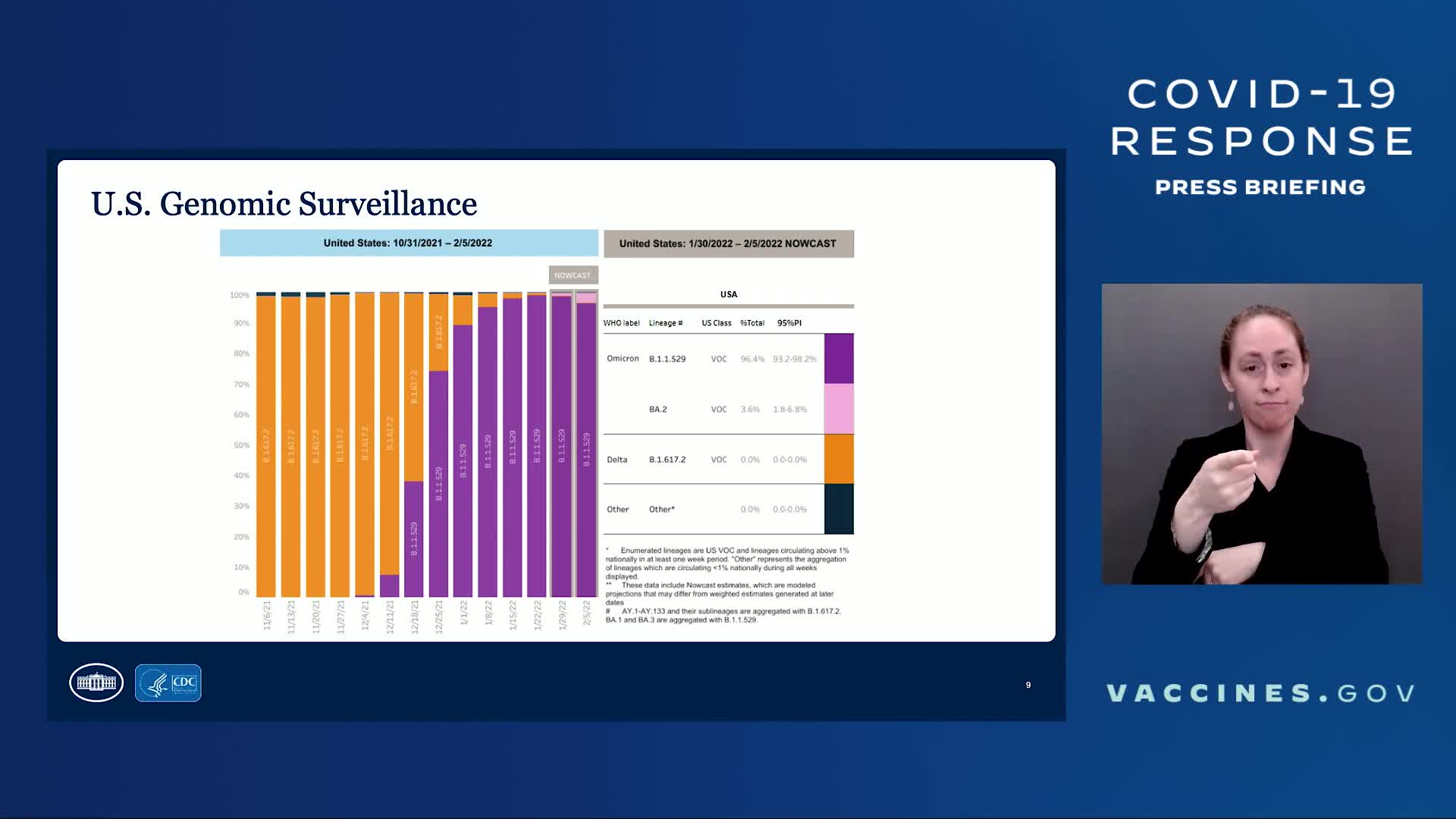
00:03:28-00:03:42 (14 sec)

"On this slide, you can see the projections of variant proportions for the last 14 weeks. Omicron, shown in pink and purple, now represents nearly 100 percent of viruses circulating in the United States."
17
Rochelle Walensky
Very Positive

00:03:42-00:03:59 (17 sec)

"Our cohort studies and state-level surveillance data provide detailed and regular reports of how our vaccines are working in the real world among diverse populations, giving us faster and better data to know that our vaccines are working against new and emerging variants."
18
Rochelle Walensky
Very Positive

00:03:59-00:04:25 (26 sec)

"You've heard me discuss many of these platforms before, like our hospital surveillance through CDC's COVID-NET and IVY; our collaboration with seven integrated healthcare and public health research centers through VISION; surveillance of infection is essential in frontline workers in HEROES-RECOVER; and our nationwide surveillance of vaccine effectiveness in children and young adults in overcoming COVID-19."
19
Rochelle Walensky
Slightly Positive

00:04:25-00:04:34 (9 sec)

"Taken together, these studies provide us an in-depth and comprehensive understanding of how vaccines are working with participations in sites nationwide."
20
Rochelle Walensky
Very Positive

00:04:34-00:04:43 (9 sec)

"And importantly, COVID-19 vaccines are being administered under the most intensive vaccine safety monitoring effort in the United States' history."
21
Rochelle Walensky
Very Positive

00:04:43-00:05:06 (23 sec)

"Our nationwide vaccine safety networks -- such as V-safe, which provides personalized and confidential health check-ins via text message -- and other systems -- such as VAERS, the Clinical Immunization Safety project, and the Vaccine Safety Datalink -- empower us with the data of any rare side effects or reactions after vaccination or boosting."
22
Rochelle Walensky
Very Positive
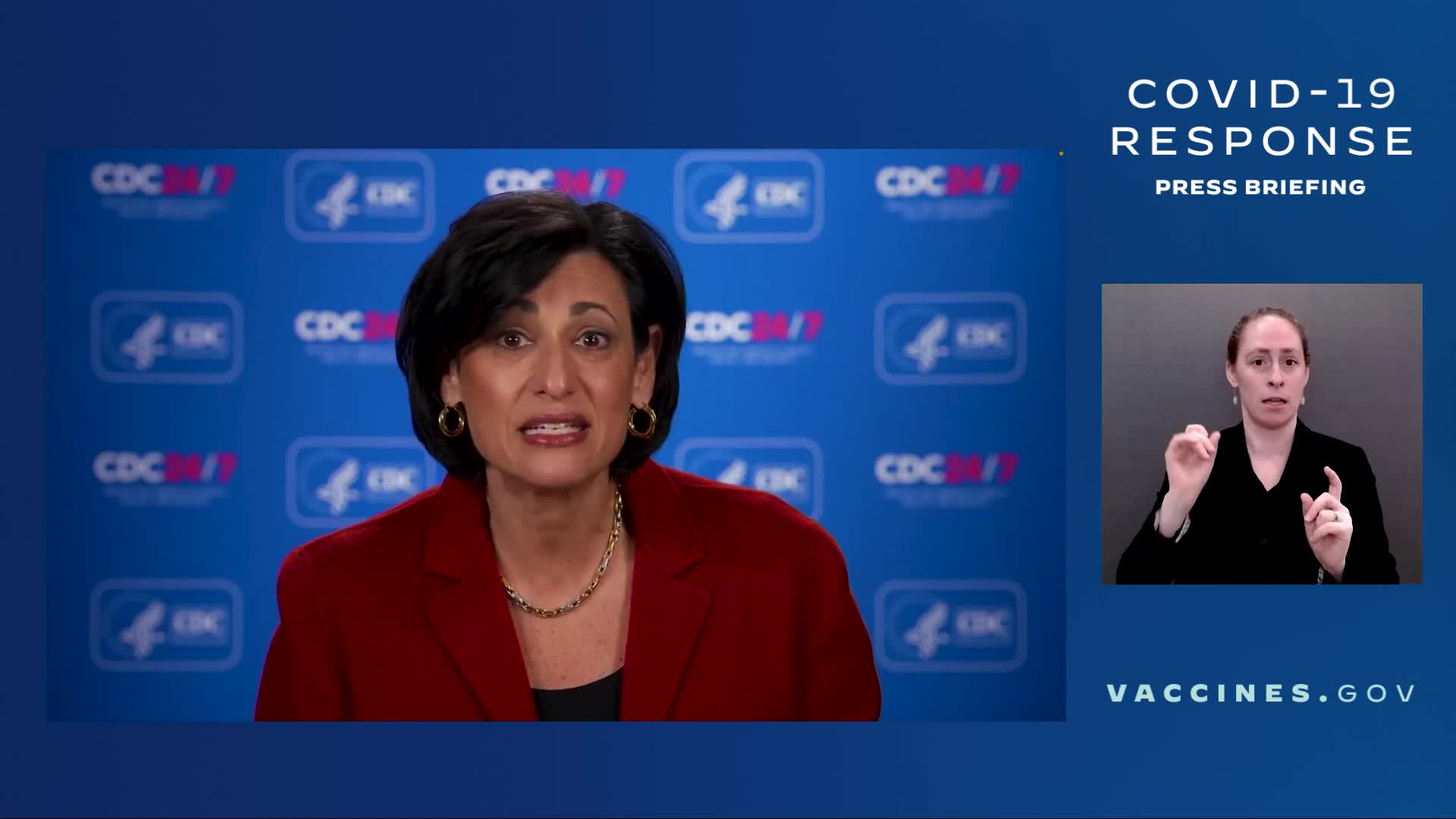
00:05:06-00:05:23 (16 sec)

"This is a huge amount of data. CDC -- along with our partners across government; state and local jurisdictions; academia; and healthcare -- has cast a wide and comprehensive net over the country to follow the virus and its impacts in real time."
23
Rochelle Walensky
Neutral

00:05:23-00:05:31 (8 sec)

"And we will continue these data as our guiding -- using these data as our guiding source as we look to what comes next."
24
Rochelle Walensky
Very Negative

00:05:31-00:05:48 (17 sec)

"I know there will come a time when we move from a phase of crisis to a point where COVID-19 is not disrupting our daily lives. And as we all look forward to this next step, I want to instill in everyone that moving forward from this pandemic will be a process that's led by our surveillance and our data."
25
Rochelle Walensky
Very Positive

00:05:48-00:05:54 (6 sec)

"I'm confident that CDC and our public health partners are well positioned to lead the way."
26
Rochelle Walensky
Somewhat Positive

00:05:54-00:05:57 (3 sec)

"Thank you. And now, with that, I will turn things back over to you, Jeff."
27
Jeff Zients
Positive

00:05:57-00:05:59 (2 sec)

"Thanks, Dr. Walensky."
28
Jeff Zients
Positive

00:05:59-00:06:10 (11 sec)

"Now, let's move to booster shots. We know that there are a number of different ways to view progress on boosters, depending on which data set you're looking at."
29
Jeff Zients
Neutral

00:06:10-00:06:25 (15 sec)

"For example, some people assess boosters as a proportion of all adults who are fully vaccinated, while others look at the total U.S. adult population, even though not every adult is eligible for a booster shot yet."
30
Jeff Zients
Very Positive

00:06:25-00:06:40 (15 sec)

"So, before I turn to Dr. Fauci on the effectiveness of booster shots, I want to review how we assess the available data and use the best available data to measure the progress we're making on getting people booster shots."
31
Jeff Zients
Neutral

00:06:40-00:06:58 (18 sec)

"CDC data aggregated from state health departments shows that more than 90 million booster shots have been administered. We know that that is likely undercounted as some people reported their booster as a first shot and others forgot their vaccination card altogether."
32
Jeff Zients
Leans Negative

00:06:58-00:07:09 (11 sec)

"States have been matching data and have encountered some challenges across different channels, which has led to delayed reporting for booster shots in many states."
33
Jeff Zients
Positive

00:07:09-00:07:15 (6 sec)

"CDC is working with states to address these issues to improve the data."
34
Jeff Zients
Positive

00:07:15-00:07:31 (16 sec)

"At the same time, CDC conducts a weekly survey, which is a nationally representative survey of over 16,000 adults. Looking at the CDC survey results, you get a more up-to-date picture of the progress we are making on boosters."
35
Jeff Zients
Very Negative

00:07:31-00:07:49 (18 sec)

"Based on the latest CDC survey, we estimate over two thirds of all eligible adults and over 80 percent of all eligible seniors -- those most at risk and most vulnerable -- have received a booster shot."
36
Jeff Zients
Neutral

00:07:49-00:08:00 (11 sec)

"CDC's survey results are consistent with the Kaiser Family Foundation survey which shows 70 percent of eligible adults report they've gotten a booster."
37
Jeff Zients
Very Positive

00:08:00-00:08:06 (6 sec)

"So, we have a strong foundation to build on, with most eligible adults boosted."
38
Jeff Zients
Somewhat Positive

00:08:06-00:08:18 (12 sec)

"In fact, we estimate at least two out of three adult -- eligible adults in the U.S. are now boosted -- two out of three eligible adult Americans with a booster shot."
39
Jeff Zients
Very Positive

00:08:18-00:08:32 (14 sec)

"And across the last two months, we've made important strides on equity, with the majority of booster shots going to people of color, in a very improvement from the prior two months."
40
Jeff Zients
Positive

00:08:32-00:08:48 (16 sec)

"The significant progress we made on boosters is one of the reasons why we were able to confront Omicron with fewer disruptions to schools and businesses than in prior surges. And we clearly need to keep driving this progress."
41
Jeff Zients
Very Positive

00:08:48-00:09:07 (19 sec)

"So , our message is clear: All eligible individuals should get their booster shot right away. Booster shots are free. They're available at 90,000 convenient locations across the country and, as Dr. Fauci will discuss, critical to getting people the highest level of protection."
42
Jeff Zients
Neutral

00:09:07-00:09:11 (4 sec)

"With that, over to you, Dr. Fauci."
43
Anthony Fauci
Somewhat Positive

00:09:11-00:09:24 (13 sec)

"Thank you very much, Jeff. What I'm going to do now over the next couple of minutes is to just build on what Jeff said and talk to you, based on real data, why it is so critically important to get booster shots."
44
Anthony Fauci
Neutral

00:09:24-00:09:30 (6 sec)

"I'm going to talk about laboratory data, clinical trial data, and real-world data."
45
Anthony Fauci
Neutral

00:09:30-00:09:31 (1 sec)

"Next slide."
46
Anthony Fauci
Somewhat Positive

00:09:31-00:09:47 (16 sec)

"So there are multiple -- and I can't show them all -- in vitro studies that show that COVID-19 vaccine booster doses markedly increase the neutralization of variants, including what we're dealing with currently, namely Omicron."
47
Anthony Fauci
Neutral
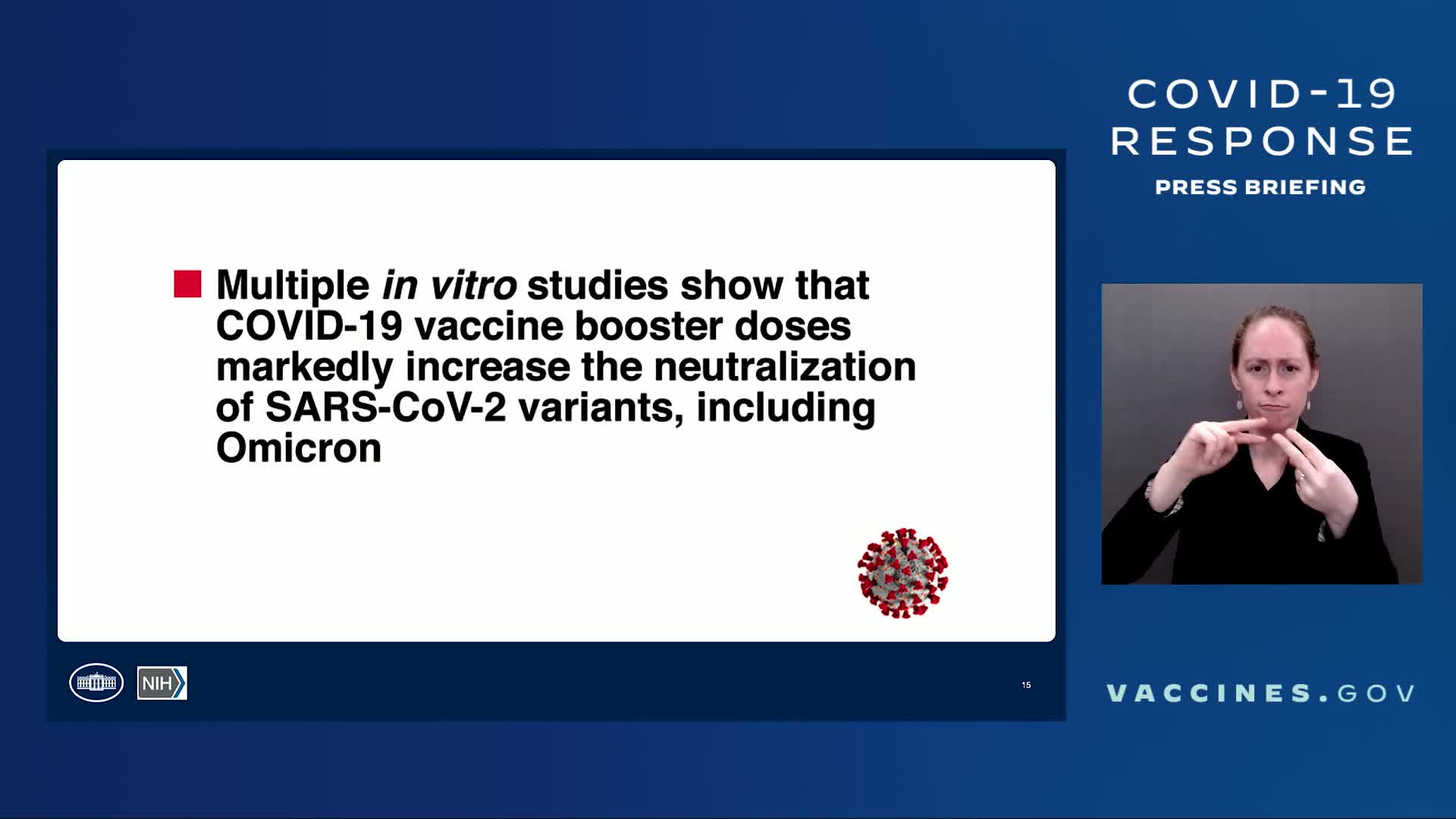
00:09:47-00:09:49 (2 sec)

"Next slide."
48
Anthony Fauci
Slightly Negative

00:09:49-00:10:20 (31 sec)

"This is the slide that shows the genomic mean titer of antibody, namely the proteins that neutralize the virus. If you look at the far left-hand side of the slide, seven months after people receive a second dose and before the booster, look how low the response is to Omicron, which is the bar that has the red circles. It's 23."
49
Anthony Fauci
Neutral

00:10:20-00:10:45 (25 sec)

"One month after the booster, it goes way up into the highly protective zone of 850. And even six months after the booster, it is still at a high level of 136 -- way above what it was seven months after the second dose. So, that's representative laboratory data."
50
Anthony Fauci
Neutral

00:10:45-00:10:46 (2 sec)

"Next slide."
51
Anthony Fauci
Neutral

00:10:46-00:11:03 (16 sec)

"Now, a randomized controlled clinical trial showed the dramatic impact of the booster dose in preventing symptomatic disease. And the data are really striking. I'll show you one clip of that on the next slide."
52
Anthony Fauci
Very Positive

00:11:03-00:11:18 (16 sec)

"As you can see in red are individuals who've gotten two doses -- it says placebo, but it's two doses -- without the booster. And this is a Pfizer study, but it really holds true with other products like Moderna."
53
Anthony Fauci
Neutral

00:11:18-00:11:30 (11 sec)

"If you look at the result in blue of the cumulative incidence of COVID-19 following a booster shot, the difference is dramatic."
54
Anthony Fauci
Neutral

00:11:30-00:11:31 (1 sec)

"Next slide."
55
Anthony Fauci
Negative

00:11:31-00:11:44 (13 sec)

"Now we'll move to real-world effectiveness studies showing that booster doses reconstitute the waning protection, especially against severe disease, hospitalization, and deaths."
56
Anthony Fauci
Neutral

00:11:44-00:11:46 (2 sec)

"So, next slide."
57
Anthony Fauci
Positive

00:11:46-00:12:09 (23 sec)

"So, here, we look at individuals less than six months after the second dose. And on the far left, you see when you're dealing with Delta, it's 90; when you're dealing with Omicron, it's 81. But more than six months after the second dose, it wanes with Omicron to 57, holding up a bit better with Delta."
58
Anthony Fauci
Very Positive

00:12:09-00:12:26 (17 sec)

"But after the third dose, you get protection at 90 percent with Omicron, which is even better than after six months after the second dose. Again, another example of the critical importance of boosting."
59
Anthony Fauci
Neutral

00:12:26-00:12:27 (1 sec)

"Next slide."
60
Anthony Fauci
Neutral

00:12:27-00:12:49 (22 sec)

"Here is another way of looking at it. When you look at symptomatic disease and hospitalizations, again, when you're dealing with Omicron, on the far left, the protection against symptomatic disease is quite low at week 25, following two doses. If you look at the boost, it goes up substantially to 40 percent."
61
Anthony Fauci
Somewhat Negative

00:12:49-00:13:08 (19 sec)

"But the critical data are on the right-hand part of the slide. If you look at hospitalizations and look at two doses of the Pfizer BioNTech either at 2 to 4 weeks or 10 to 14 weeks, it's still way up there at 75 percent."
62
Anthony Fauci
Neutral

00:13:08-00:13:10 (2 sec)

"Next slide."
63
Anthony Fauci
Very Negative

00:13:10-00:13:24 (14 sec)

"And again, if you look at CDC data, which shows a dramatic reduction in the risk of hospitalization and death for people who've received a booster dose, we can see that on the next slide."
64
Anthony Fauci
Positive

00:13:24-00:14:05 (41 sec)

"And this is a summary of data: If you compare a fully vaccinated person with one who has received a booster shot, and look at the monthly rate of COVID-19 associated hospitalizations during a timeframe of December 2021, there was a 45-fold higher likelihood of an unvaccinated person in the age range of 50 to 64, and a 51-fold higher likelihood of an unvaccinated age 65 and older of being hospitalized when you compare it to an individual with a boost."
65
Anthony Fauci
Neutral

00:14:05-00:14:07 (2 sec)

"Next slide."
66
Anthony Fauci
Very Negative

00:14:07-00:14:36 (29 sec)

"When you look at death rate, again, the data are really rather striking. If you look at unvaccinated in red and look at the death rate per 100,000 compared to a fully vaccinated person who's not been boosted -- showing you why vaccinations even without boosts are important. But look what the booster does: It brings back the death rate per 100,000 to a remarkably low level."
67
Anthony Fauci
Very Positive

00:14:36-00:14:48 (12 sec)

"So, we can only come to one conclusion on the last slide: that COVID-19 vaccines, booster shots can keep you out of the hospital and certainly can save your life."
68
Anthony Fauci
Neutral

00:14:48-00:14:50 (2 sec)

"Back to you, Jeff."
69
Jeff Zients
Positive

00:14:50-00:14:52 (2 sec)

"Thanks, Dr. Fauci."
70
Jeff Zients
Neutral
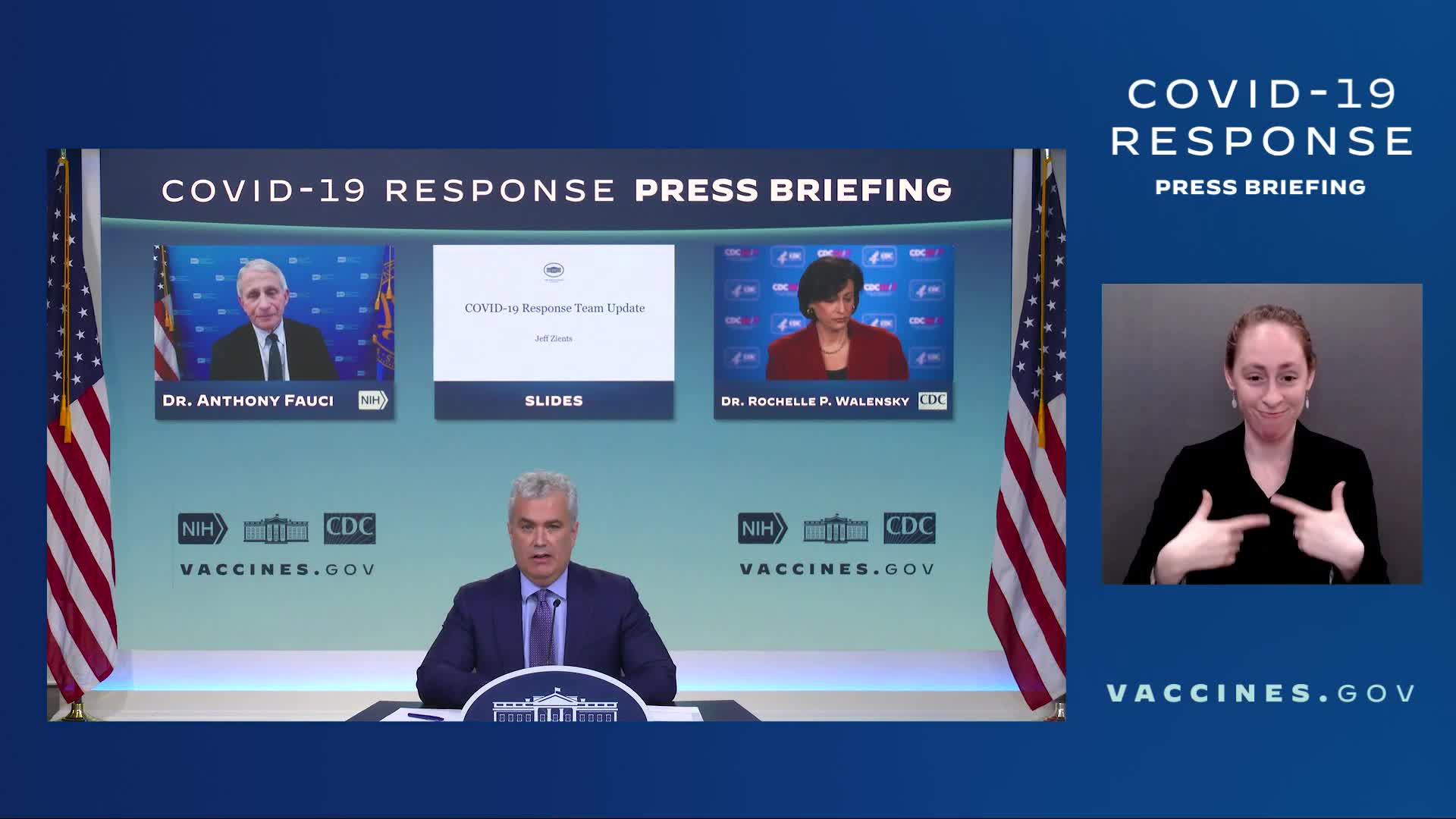
00:14:52-00:14:59 (6 sec)

"Before we open for questions, I want to highlight how far we've come in our fight against COVID."
71
Jeff Zients
Very Positive

00:14:59-00:15:11 (12 sec)

"Last week, we learned the U.S. economy created 6.6 million new jobs in the President's first year in office. That's the best 12 months of job creation in our nation's history."
72
Jeff Zients
Slightly Positive

00:15:11-00:15:23 (12 sec)

"Notably, this includes 467,000 jobs created in January and 510,000 in December. Those were the two months when we were at the height of the Omicron surge."
73
Jeff Zients
Neutral

00:15:23-00:15:50 (27 sec)

"The first time we faced a similar threat from COVID back in April of 2020, we lost around 20 million jobs in one month. Even as we face the extremely transmissible Omicron variant and saw a record number of cases, businesses stayed open and our economy kept growing stronger. That's because we're in such a different position today in terms of our ability to manage this virus."
74
Jeff Zients
Very Positive

00:15:50-00:16:03 (13 sec)

"We have over 210 million people fully vaccinated and vaccines freely available. And we have more tools like boosters, treatments, masks, and tests that give us additional layers of protection."
75
Jeff Zients
Very Positive

00:16:03-00:16:19 (16 sec)

"Today, fully vaccinated and boosted Americans are able to keep living their lives safely, even when this virus throws us a curveball. And we're able to keep our kids in school and keep our businesses open."
76
Jeff Zients
Neutral

00:16:19-00:16:34 (16 sec)

"As the President said on Friday, January was a tough month for this country, but we got through it together. Over the past three weeks, daily cases are down over 65 percent; hospital admissions are down 40 percent."
77
Jeff Zients
Very Positive

00:16:34-00:16:53 (19 sec)

"The President's COVID plan is working. We're moving toward a time when COVID won't disrupt our daily lives, a time when COVID won't be a constant crisis but rather will be something we can protect against and treat."
78
Jeff Zients
Neutral

00:16:53-00:17:00 (7 sec)

"With that, let's open it up for a few questions. Over to you, Kevin."
79
Operator
Positive

00:17:00-00:17:06 (6 sec)

"Thanks, Jeff. We've got a lot of questions today. So, let's actually try to keep it to one question."
80
Operator
Neutral

00:17:06-00:17:10 (4 sec)

"First, let's go to Zeke Miller at the AP."
81
Question
Positive

00:17:10-00:17:28 (18 sec)

"Thanks. In the last week, we've seen a number of Democratic-led -- -run states move back towards normalcy, removing mask mandates. New York is expected to follow today. We saw Connecticut, other states lift mask requirements in schools."
82
Question
Very Positive
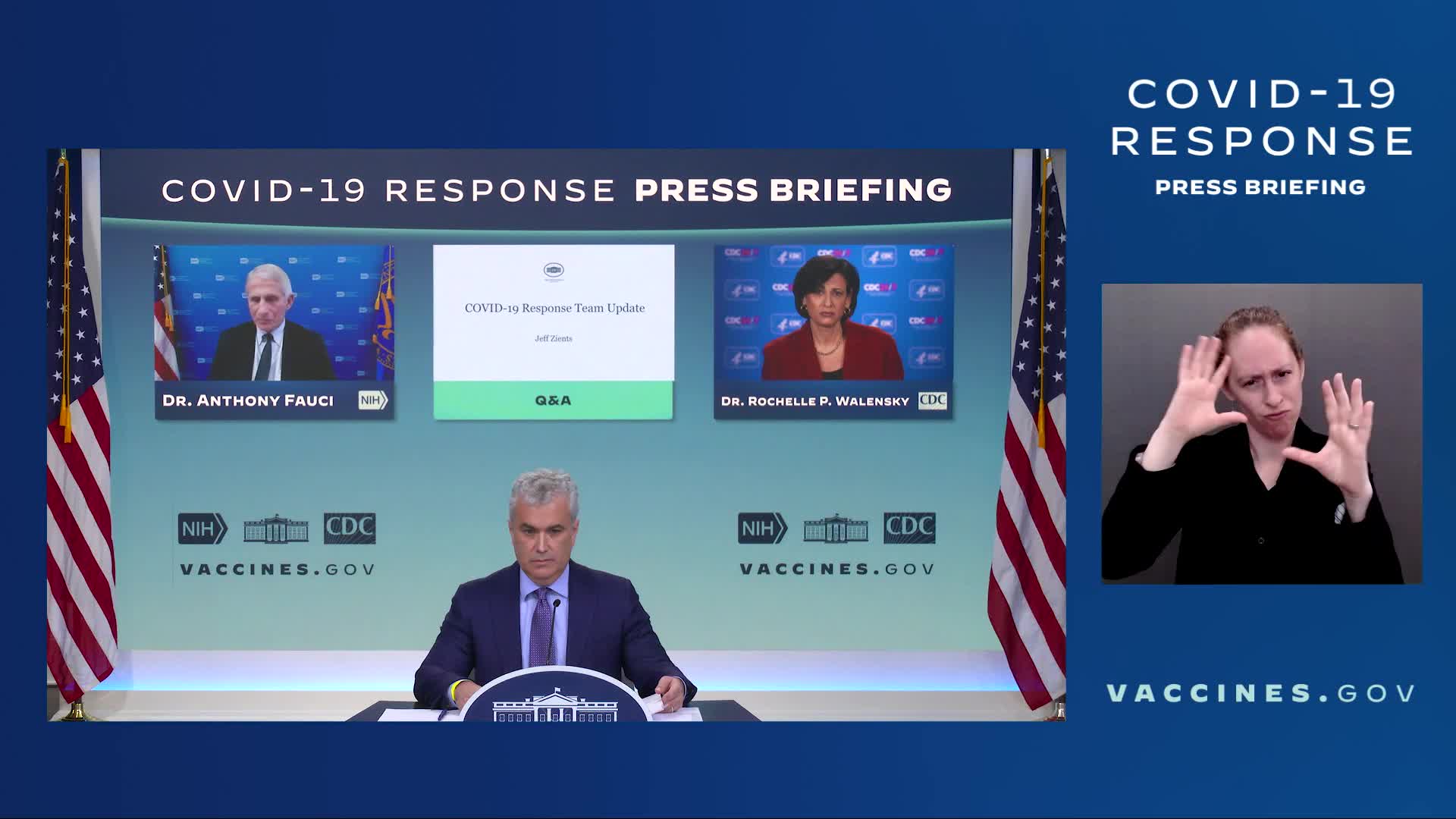
00:17:28-00:17:45 (18 sec)

"You've talked a lot about leading -- the President trying to lead the nation out of the pandemic, but right now, the federal response seems to be following what a lot of states are doing. Is the White House planning for emerging -- bringing the country out of the pandemic? And what would that plan look like?"
83
Jeff Zients
Very Positive

00:17:45-00:17:58 (12 sec)

"Well, thanks for the question. So while cases and hospitalizations, as Dr. Walensky showed, are trending downward, we do remain focused on fighting the Omicron surge. So, that's priority number one."
84
Jeff Zients
Very Positive

00:17:58-00:18:31 (33 sec)

"The President, as I just mentioned, has been clear that we're moving toward a time when COVID won't disrupt our daily lives, a time when COVID won't be a constant crisis so we're no longer fearing lockdowns and shutdowns, but getting back to safely doing what we all love. In doing so, we will rely on the powerful set of tools that have been built: the vaccines, the booster shots, treatments, and testing."
85
Jeff Zients
Slightly Positive

00:18:31-00:18:57 (26 sec)

"For the last several weeks, we've been working closely with Secretary Becerra, our team of doctors. And the White House COVID Response Team under the President's leadership is reaching out to governors and outside public health experts and doctors and local public health officials on steps we should be taking to keep the country moving forward."
86
Jeff Zients
Somewhat Negative

00:18:57-00:19:11 (15 sec)

"We know that in different areas of the country, cases have fallen more significantly, and this will lead to different approaches and different timing. And we will continue to coordinate closely with state and local leaders."
87
Jeff Zients
Neutral

00:19:11-00:19:14 (3 sec)

"Next question."
88
Operator
Neutral

00:19:14-00:19:16 (2 sec)

"Let's go to Sabrina Siddiqui at the Wall Street Journal."
89
Question
Very Positive

00:19:16-00:19:46 (30 sec)

"Thank you so much. This is a question for Dr. Walensky. I just want to follow up on current guidance around masks, because, you know, the last CDC recommendation was that there should be indoor masking in public settings where transmission is substantial or high. According to CDC data, that appears to still be the entire country -- the case in the entire country where community transmission is high. So is that still the recommendation?"
90
Question
Neutral

00:19:46-00:20:00 (14 sec)

"And furthermore, you've also recommended that there be universal masking in schools. Is that -- is that a recommendation you stand by as states are also moving to drop -- or to lift mask mandates for teachers and students in schools?"
91
Jeff Zients
Neutral

00:20:00-00:20:02 (2 sec)

"Dr. Walensky?"
92
Rochelle Walensky
Very Positive

00:20:02-00:20:12 (10 sec)

"Yeah, thank you, Sabrina. So we certainly understand the need and desire to be flexible, and we want to ensure the public health guidance that we're providing meets the moment that we're in."
93
Rochelle Walensky
Positive

00:20:12-00:20:25 (13 sec)

"As we've discussed and as you noted, cases and hospitalizations are falling. This is, of course, encouraging. And that leads us, of course, to have us look at all of our guidance based on the latest data and the science and what we know about the virus."
94
Rochelle Walensky
Neutral

00:20:25-00:20:36 (11 sec)

"We also look, of course, as Jeff mentioned, to our hospitalizations, looking at the hospitals as a barometer of how they're doing locally so those decisions can be made at the local level."
95
Rochelle Walensky
Positive

00:20:36-00:20:44 (8 sec)

"And, of course, we at CDC will keep the public informed about our guidance, and we will clearly communicate those recommendations to the public if and when they are updated."
96
Rochelle Walensky
Somewhat Positive

00:20:44-00:20:46 (2 sec)

"Thank you."
97
Jeff Zients
Somewhat Positive
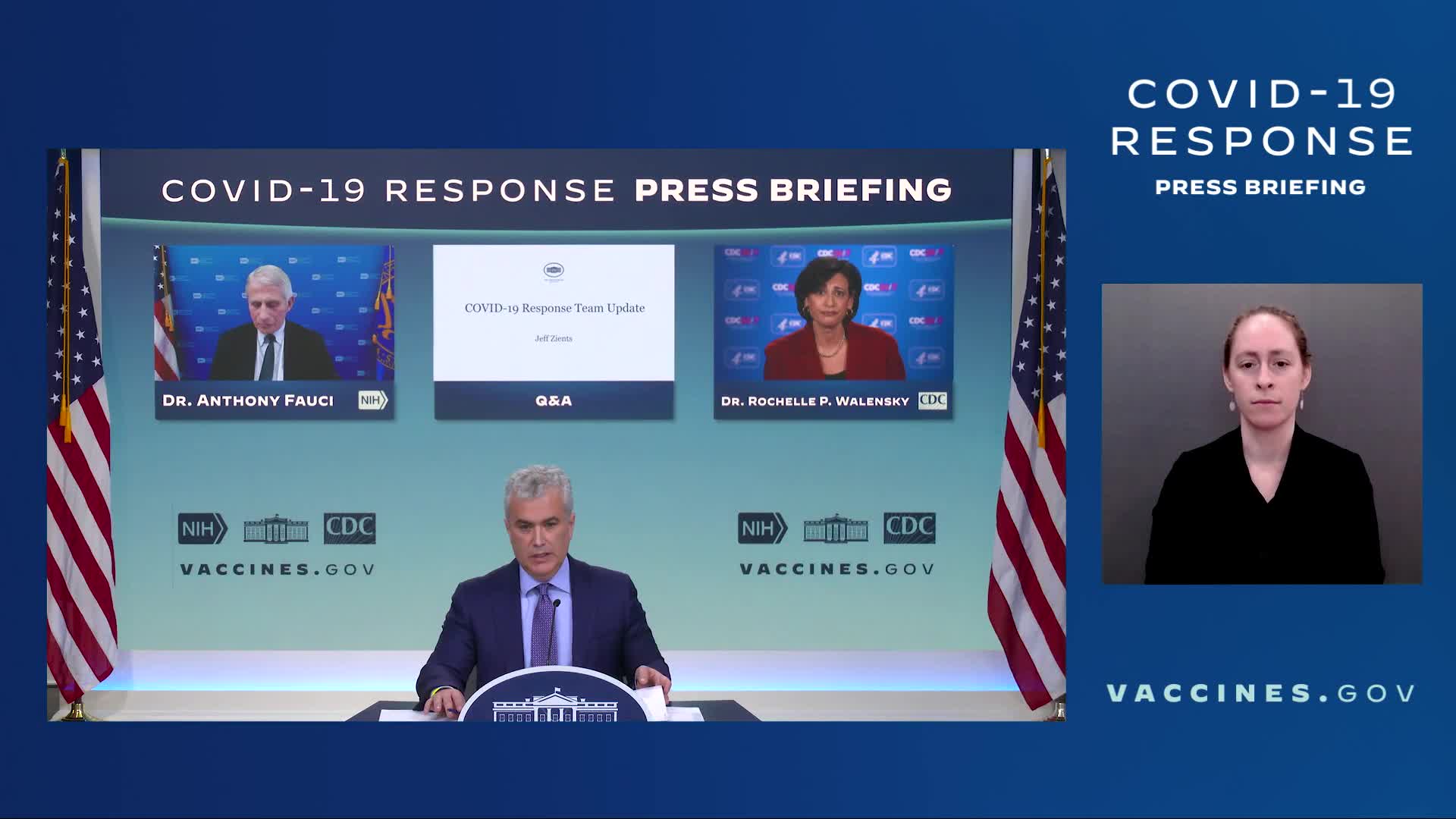
00:20:46-00:20:47 (1 sec)

"Next question, please."
98
Operator
Neutral

00:20:47-00:20:52 (5 sec)

"We'll go to Cheyenne Haslett at ABC News."
99
Question
Very Positive

00:20:52-00:21:09 (17 sec)

"Hi, thank you. Dr. Walensky, you mentioned the specific benchmarks on hospitalization that you're looking to for when it will be a good time to change some of this guidance for unmasking, both in schools and generally in public for adults. What exactly will that benchmark be?"
100
Rochelle Walensky
Neutral

00:21:09-00:21:22 (13 sec)

"Right. So, Cheyenne, we -- you know, in part of our review of the surveillance, we look at wastewater, we look at cases, we look at hospitalizations -- we've been reporting hospitalizations -- we look at deaths. And, of course, those decisions are made at the local level."
101
Rochelle Walensky
Positive

00:21:22-00:21:43 (21 sec)

"But at this time, we continue to recommend masking in areas of high and substantial transmission -- that's much of the country right now -- in public indoor settings. And so we're, of course, taking a close look at this in real-time, and we're evaluating rates of transmission as well as rates of severe outcomes as we look at updating and reviewing our guidance."
102
Jeff Zients
Somewhat Positive

00:21:43-00:21:47 (3 sec)

"Next question, please."
103
Operator
Neutral

00:21:47-00:21:49 (2 sec)

"We'll go to Victoria Knight at Kaiser Health News."
104
Question
Very Positive

00:21:49-00:22:25 (36 sec)

"Thanks so much for taking my question. So, I've been talking to people who are immunocompromised, people who are disabled, living with chronic illnesses, and they're all telling me that they're feeling like they are being left behind, especially in light of a lot of states lifting their mask mandates, and they're feeling like their needs are not being considered moving forward after Omicron. So what is your message to them? What do you expect them to do? Do they need to just stay in their houses? What is your message to people like that?"
105
Jeff Zients
Neutral

00:22:25-00:22:26 (2 sec)

"Dr. Walensky?"
106
Rochelle Walensky
Neutral

00:22:26-00:22:54 (27 sec)

"Right. So this is among the considerations that we take into account as we work on all of our recommendations. We, of course, have to make recommendations that are, you know, relevant for New York City and rural Montana. We have to make recommendations that are met -- relevant for the public, but also for the public who is immunocompromised and disabled. And so, that -- all of those considerations are taken into account as we work on our guidance."
107
Jeff Zients
Somewhat Positive

00:22:54-00:22:59 (5 sec)

"Next question, please."
108
Operator
Neutral

00:22:59-00:23:03 (4 sec)

"Let's go to Kaitlan Collins at CNN."
109
Question
Very Positive

00:23:03-00:23:25 (22 sec)

"Thanks so much. Dr. Walensky, you just said that you do continue to recommend masking indoors in areas of high transmission, and that you said that that's most of the country right now. So are you seeing any data that supports the decisions of these governors to drop mandates? And when it comes to masking, should people be listening to the CDC or listening to their governors?"
110
Rochelle Walensky
Neutral

00:23:25-00:23:39 (14 sec)

"Kaitlan, we've always said that these decisions are going to have to be made at the local level and that policies at the local level will look at local cases, they'll look at how local hospitals are doing, they'll look at local vaccination rates."
111
Rochelle Walensky
Leans Negative

00:23:39-00:23:48 (10 sec)

"And they, as I understand it, in many of these decisions are using a phased approach. Not all of these decisions are being made to stop things tomorrow, but they're looking at a phased approach."
112
Rochelle Walensky
Leans Negative

00:23:48-00:24:03 (15 sec)

"And so, what I would say is: Again, they have to be done at the local level. But I'm really encouraged that cases are continuing to drop dramatically, hospitalizations are continuing to drop dramatically as people are making these decisions and as we are working on our guidance."
113
Rochelle Walensky
Positive

00:24:03-00:24:05 (2 sec)

"So I'm encouraged to see those trends."
114
Jeff Zients
Somewhat Positive

00:24:05-00:24:07 (2 sec)

"Next question, please."
115
Operator
Neutral

00:24:07-00:24:11 (4 sec)

"Let's go to Sheryl Stolberg at the New York Times."
116
Jeff Zients
Neutral

00:24:11-00:24:18 (7 sec)

"Sheryl?"
117
Question
Neutral

00:24:18-00:24:21 (3 sec)

"Can you hear me?"
118
Jeff Zients
Positive

00:24:21-00:24:22 (1 sec)

"Now we can, yes."
119
Question
Very Positive

00:24:22-00:24:38 (16 sec)

"Sorry about that. Thank you for taking this question -- it's for Dr. Walensky. Dr. Walensky, the states have been asking explicitly, governors have been asking explicitly for guidance from the CDC on mask-wearing and how to relax mitigation numbers."
120
Question
Somewhat Positive

00:24:38-00:24:44 (7 sec)

"Is the CDC prepared to provide guidance to the governors? And when will it do so?"
121
Rochelle Walensky
Very Positive

00:24:44-00:24:56 (11 sec)

"Sheryl, thank you. And I'll simply go back to: Yes, we are prepared. We are working on that guidance. We are working on, you know, following the trends for the moment."
122
Rochelle Walensky
Somewhat Negative

00:24:56-00:25:08 (13 sec)

"What I will say though is, you know, our hospitalizations are still high, our death rates are still high. So, as we work towards that and as we are encouraged by the current trends, we are not there yet."
123
Jeff Zients
Somewhat Positive

00:25:08-00:25:12 (4 sec)

"Next question, please."
124
Operator
Neutral

00:25:12-00:25:16 (4 sec)

"Let's go to Kristen Welker at NBC."
125
Question
Positive

00:25:16-00:25:39 (23 sec)

"Hi, everyone. Thanks so much for doing this call. I know that you have spoken in the past about the fact that we could be moving closer to having a vaccine for children under the age of five. And obviously, when you look at some of the polling, it's potentially concerning: Just 3 in 10 parents of children under the age of five say that they'll get their child vaccinated."
126
Question
Very Positive

00:25:39-00:25:57 (18 sec)

"Can you update us on your latest efforts once those vaccines are approved to reach those parents who are still skeptical? What should they know? And why should they have confidence in the vaccines once they are approved? What will your messaging be, and what are your latest outreach efforts?"
127
Jeff Zients
Very Positive

00:25:57-00:26:11 (14 sec)

"Well, Dr. Fauci, maybe you can do a minute or two on the under-five vaccine status. And then I'll talk some about both the operational issues and the -- answering questions and building confidence work."
128
Jeff Zients
Neutral

00:26:11-00:26:13 (2 sec)

"Dr. Fauci."
129
Anthony Fauci
Very Positive

00:26:13-00:26:14 (1 sec)

"Yeah. Thank you, Jeff."
130
Anthony Fauci
Very Positive

00:26:14-00:26:31 (17 sec)

"Yes, the data from the trials on children from 6 months to 24 months, as well as those from 21 months to -- up to the end of 4 years have been conducted by the pharmaceutical company, in this case, Pfizer."
131
Anthony Fauci
Very Positive

00:26:31-00:27:00 (29 sec)

"The data have been submitted to the FDA, and the FDA VRBPAC, or their advisory committee, will be meeting on February 15th. I think people need to be assured that any decision that the FDA makes, as is historically always the case with them, will really be based on the scientific data of both safety and efficacy. And we can assure you that the decision will be based on that."
132
Anthony Fauci
Very Positive

00:27:00-00:27:08 (8 sec)

"And if, in fact, approved, it will be approved on the fact that the data show clear efficacy and safety."
133
Anthony Fauci
Neutral

00:27:08-00:27:10 (3 sec)

"So, I'll go back to you, Jeff, for the rest of that question."
134
Jeff Zients
Very Positive

00:27:10-00:27:31 (20 sec)

"Thanks, Dr. Fauci. So, operationally, we will be ready once FDA and CDC make their recommendations. As we talked about last week, this vaccine is specifically formulated for these young kids. So, we're launching a new program specially for kids under five."
135
Jeff Zients
Very Positive

00:27:31-00:27:52 (21 sec)

"The planning process is well underway. CDC is working with states to help them prepare. We've secured enough vaccine supply for all kids in this age group -- all 18 million. We have enough needles, syringes, and kits. And these are all specially formulated, are made for this age group to send alongside the vaccine."
136
Jeff Zients
Very Positive

00:27:52-00:28:07 (15 sec)

"And we're working closely, you know, with pediatricians and family doctors and children's hospitals and pharmacies to make sure the vaccine is available at thousands of locations across the country -- locations that parents know and trust."
137
Jeff Zients
Very Positive

00:28:07-00:28:18 (11 sec)

"We can start packing and shipping the vaccine once FDA makes its decision. So, we will be prepared for those parents that are eager to get their kids vaccinated."
138
Jeff Zients
Very Positive

00:28:18-00:28:36 (18 sec)

"I think the second part of your question is -- there are parents that are -- that do have questions, and we need to answer those questions. And we've learned through our efforts across the last year that the best messengers are local messengers -- local community groups and leaders, doctors, and other health practitioners."
139
Jeff Zients
Somewhat Positive

00:28:36-00:28:51 (15 sec)

"So, we are working closely with HHS to line up that group and make sure that they have the materials that they need, the training they need to be able to answer the questions that parents have about getting their kids vaccinated."
140
Jeff Zients
Somewhat Positive

00:28:51-00:28:52 (1 sec)

"Next question, please."
141
Operator
Neutral

00:28:52-00:29:01 (9 sec)

"Last question. Let's go to Josh Wingrove of Bloomberg."
142
Question
Somewhat Positive

00:29:01-00:29:12 (11 sec)

"Hi there. Thank you very much. Dr. Fauci, can you talk a little bit more about what you think the data show now of the need for a shot beyond the third dose, beyond a booster?"
143
Question
Neutral

00:29:12-00:29:21 (9 sec)

"As you know, boosters are being given as early as five months -- we are approaching five months now -- some of the -- first folks who got it."
144
Question
Somewhat Positive

00:29:21-00:29:30 (9 sec)

"What do we know about how often or if further shots will be needed going forward, and in particular, whether we might need specific types of shots for any variant? Thank you."
145
Anthony Fauci
Very Positive

00:29:30-00:30:01 (31 sec)

"Yeah. Yeah, thank you for that question. That's obviously an issue that have been followed very closely. Because as I've said in answer to questions on previous press conferences -- similar questions -- is that you follow individuals for a period of time after the third dose and you measure a number of phenomenon. You measure laboratory phenomenon, but you measure the real-world data on the efficacy in preventing, for example, hospital visits, as well as hospitalizations."
146
Anthony Fauci
Neutral

00:30:01-00:30:10 (9 sec)

"And I believe that you're going to be hearing data about that as they -- data become available. And that should not be within a very long period of time."
147
Anthony Fauci
Somewhat Positive

00:30:10-00:30:25 (15 sec)

"I think you should be appreciative of the fact that when you're talking about any decisions that will be made -- and I'm not anticipating any of that now -- but that has to be put into the context of whom you're talking about."
148
Anthony Fauci
Very Positive

00:30:25-00:30:39 (14 sec)

"For example, there may be the need for yet again another boost -- in this case, a fourth-dose boost for an individual receiving the mRNA -- that could be based on age, as well as underlying conditions."
149
Anthony Fauci
Slightly Positive

00:30:39-00:30:53 (14 sec)

"So, I don't think you're going to be hearing, if you do, any kind of recommendations that would be across the board for everyone. It very likely will take into account what subset of people have a diminished, or not, protection against the important parameters such as hospitalization."
150
Jeff Zients
Somewhat Positive

00:30:53-00:30:54 (1 sec)

"Thank you, everybody. We look forward to the next briefing."
151
Jeff Zients
Neutral

00:30:54-00:31:09 (14 sec)

"To view the COVID Press Briefing slides, visit: https://www.whitehouse.gov/wp-content/uploads/2022/02/COVID-Press-Briefing-2.9.22-clean.pdf"
152